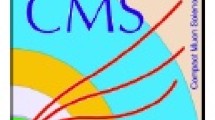Summary
After a description of the methods used in the measurements of momentum and range, the data on 46 S-events obtained with a double cloud-chamber experiment are examined. Momentum-range measurements on 22 positive S’s give a mass consistent with a single value at (928 ± 13) me. The analysis of the ranges of the secondaries shows, however, that not all S-events can be explained by a single decay mode. A large proportion of the secondaries correspond to a light meson of unique range (75.7 ± 1.7) g·cm−2 Cu. The comparison of this range with the measured masses of the primary particles proves that these secondaries are μ-mesons. The accompanying neutral secondary is shown at the same time to be a particle of zero mass. The absence of cascade showers associated with S-events with long-range secondaries shows that the neutral secondary is a neutrino. The decay mode Kμ → μ + ν previously proposed is more firmly established. Two independent mass estimates are obtained for the Kμ-particle. One—from momentum-range measurements—gives directly (906 ± 27) me. Another—from the mode of decay and the range of the μ-secondary—gives indirectly (941 ± 11) me. A final best mass of (935 ± 15) me is obtained by the combination of the two estimates after taking into account possible additional errors. The Kμ-particle is then shown to be essentially positive and to constitute (66 ± 18)% of the S’s which passed through the top chamber. No precise information can be obtained as to the mode of decay of S-particles which are known not to belong to the Kμ-decay mode.
Riassunto
Dopo una descrizione dei metodi usati nelle misure di momento e di percorso si esaminano i dati di 46 eventi S ottenuti da un’esperienza eseguita con una doppia camera a nebbia. Misure di momento-percorso eseguite su 22 S positivi dànno una massa compatibile con un valore unico a (928 ± 13) me. L’analisi dei percorsi dei secondari mostra, tuttavia, che non tutti gli eventi S si possono spiegare con un unico tipo di decadimento. Una forte proporzione di secondari corrisponde a un mesone leggero con p rcorso residuo unico (75,7 ± 1,7) g·cm2 Cu. Il confronto di questo percorso con le masse misurate delle particelle primarie prova che questi secondari sono mesoni μ. Contemporaneamente si dimostra che il secondario neutro che li accompagna è una particella di massa zero. L’assenza di sciami in cascata associati ad eventi S con secondari di lungo percorso dimostra che il secondario neutro è un neutrino. Il processo di decadimento Kμ → μ + ν precedentemente proposto risulta maggiormente confermato. Si ottengono per la particella Kμ due valutazioni di massa indipendenti. Una, da misure di momento-percorso, dà direttamente (960 ± 27) me. Un’altra, dal processo di decadimento, e dal percorso del μ secondario, dà indirettamente (941 ± ± 11) me. Infine, dalla combinazione dei due precedenti valori, dopo aver tenuto conto dei possibili errori addizionali, si ottiene per la massa un valore più probabile finale di (935 ± 15) me. Si mostra poi che la particella Kμ è essenzialmente positiva e costituisce il (66 ± 17)% degli S passati attraverso la camera superiore. Non si possono ottenere dati precisi sul decadimento delle particelle S che risultano non seguire il processo di decadimento delle particelle Kμ.
Similar content being viewed by others
Bibliography
M. Annis, W. Cheston andH. Primakoff:Rev. Mod. Phys.,25, 818 (1953).
R. Armenteros, B. Gregory, A. Lagarrigue, L. Leprince-Ringuet, F. Muller andC. Peyrou:Suppl. Nuovo Cimento,12, 327 (1954).
W. A. Aron: University of California, Thesis. UCRL 1325 (1951) (not published).
H. A. Bethe:Phys. Rev.,70, 821 (1946).
H. Bridge, H. Courant, B. Dayton, H. C. DeStaebler, B. Rossi, R. Safford andD. Willard:Nuovo Cimento,12, 81 (1954).
R. H. Brown, U. Camerini, P. H. Fowler, H. Muirhead, C. F. Powell andD. M. Ritson:Nature,163, 82 (1949).
H. Courant: MIT, Thesis (1954) (not published).
C. C. Dilworth, L. Scarsi andG. P. S. Occhialini:Annual Reviews of Nuclear Science, vol.4 (1954).
W. Friedlander, D. Keefe, M. G. K. Menon andL. van Rossum:Phil. Mag.,45, 1043 (1954).
B. Gregory, A. Lagarrigue, L. Leprince-Ringuet, F. Muller andC. Peyrou:Nuovo Cimento,11, 292 (1954).
T. F. Hoang, L. Jauneau, J. Jouvin, G. Kayas, L. Leprince-Ringuet, D. Morellet, A. Orkin-Lecourtois andJ. Trembley:Suppl. Nuovo Cimento (1955).
A. L. Hodson, J. Ballam, W. H. Arnold, D. R. Harris, R. R. Rau, G. T. Reynolds andS. B. Treiman:Phys. Rev.,96, 1089 (1954).
M. G. K. Menon andC. O’Ceallaigh:Proc. Roy. Soc., A221, 292 (1954).
C. O’Ceallaigh:Phil. Mag.,42, 1032 (1951).
V. A. Regener:Phys. Rev. 84, 161 (1951).
M. Rich andR. Madey: University of California, UCRL 2301 (1954) (not published).
B. Rossi: Varenna Summer School (1954) (MS. kindly sent to us by Prof.Rossi).
Author information
Authors and Affiliations
Additional information
The cost of the experiment has been shared by le Commissariat à l’Energie Atomique and l’Enseignement Supérieur.
Rights and permissions
About this article
Cite this article
Armenteros, R., Gregory, B., Hendel, A. et al. Further discussion of the Kμ decay modedecay mode. Nuovo Cim 1, 915–941 (1955). https://doi.org/10.1007/BF02731337
Received:
Published:
Issue Date:
DOI: https://doi.org/10.1007/BF02731337




